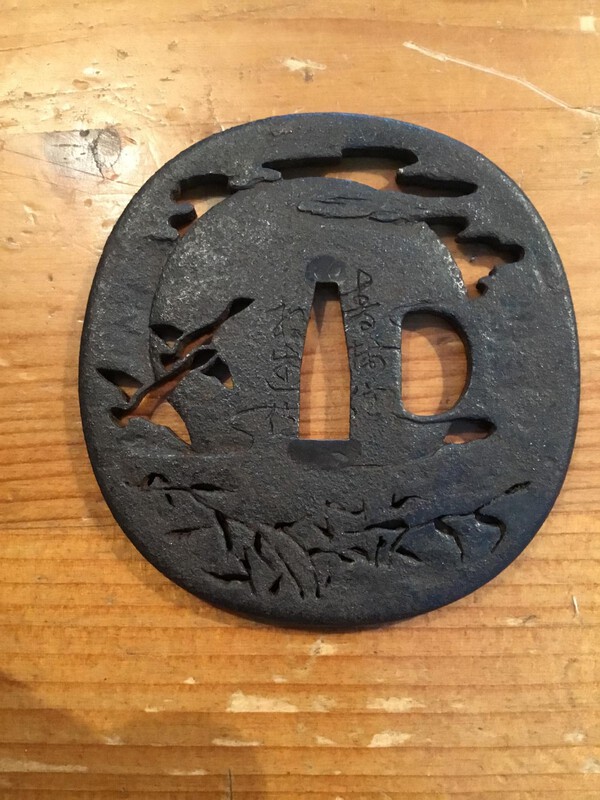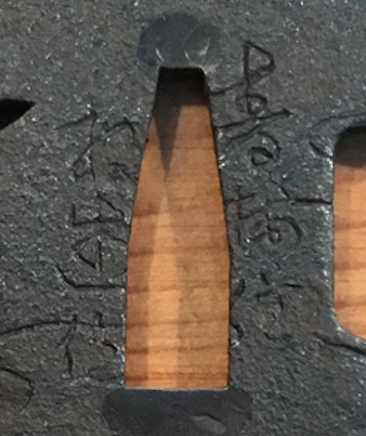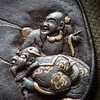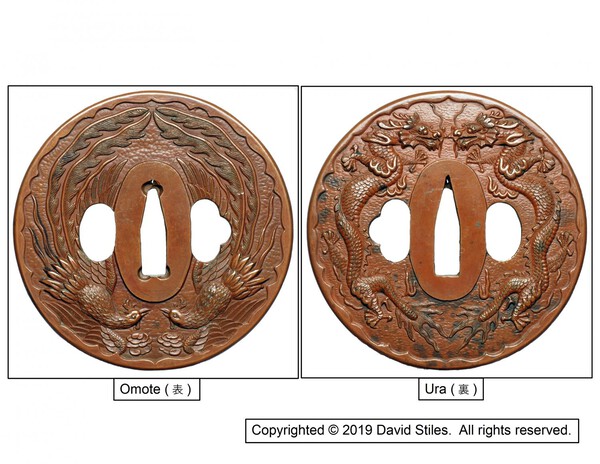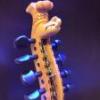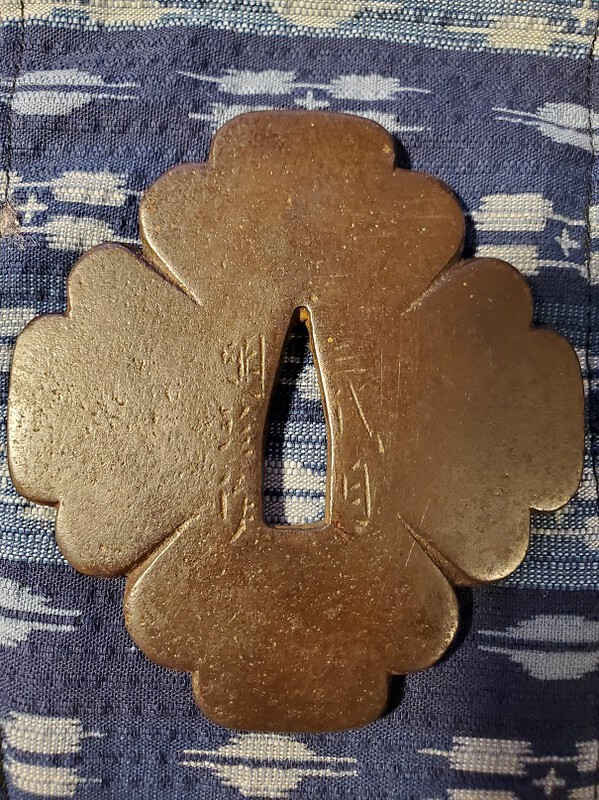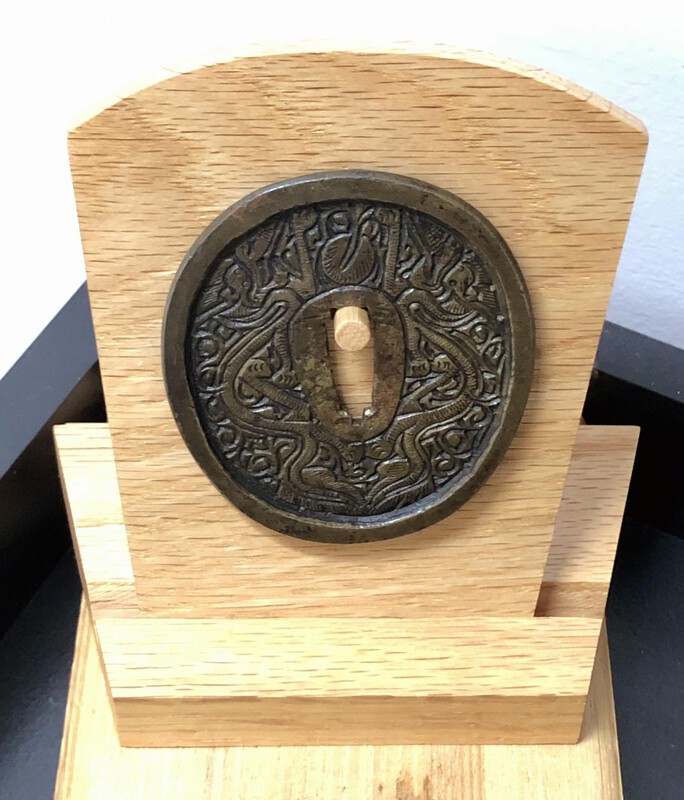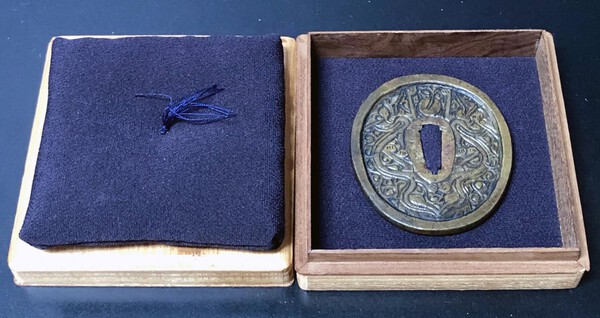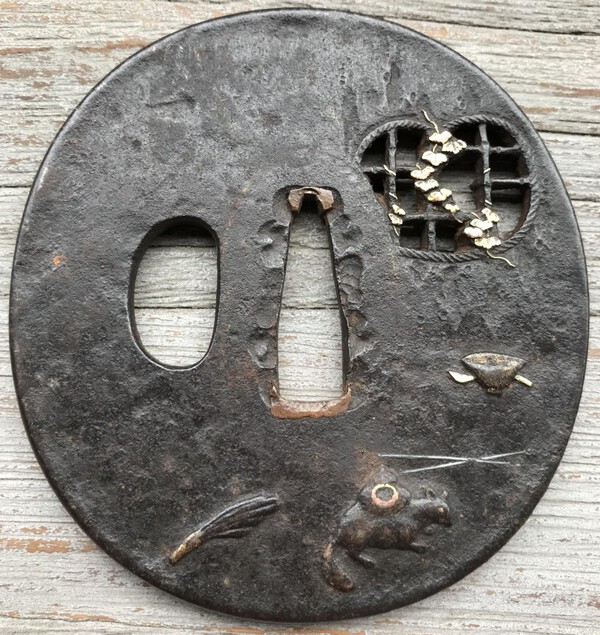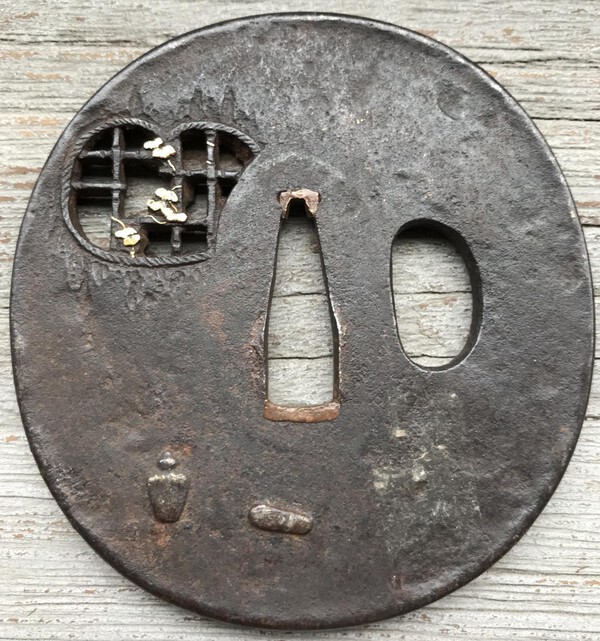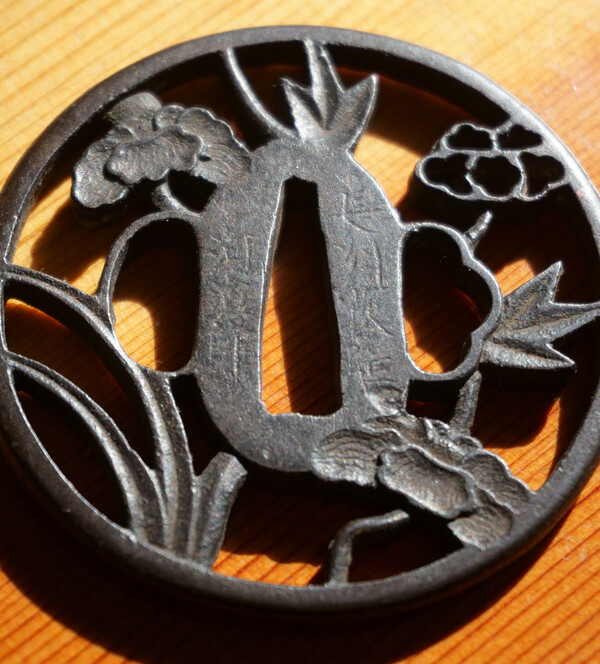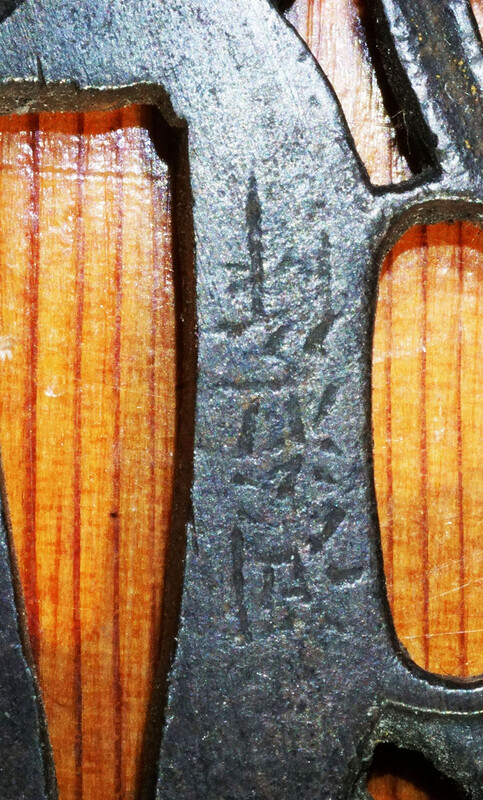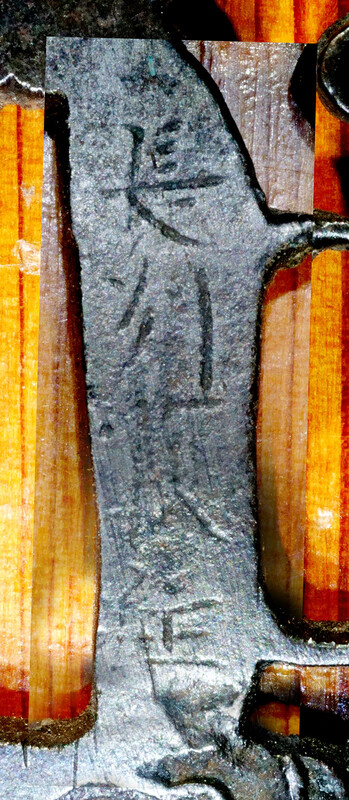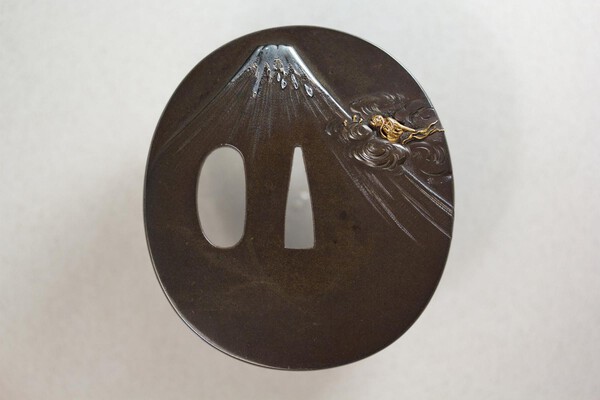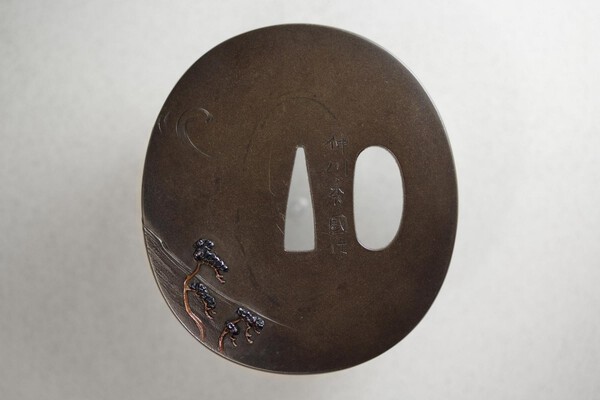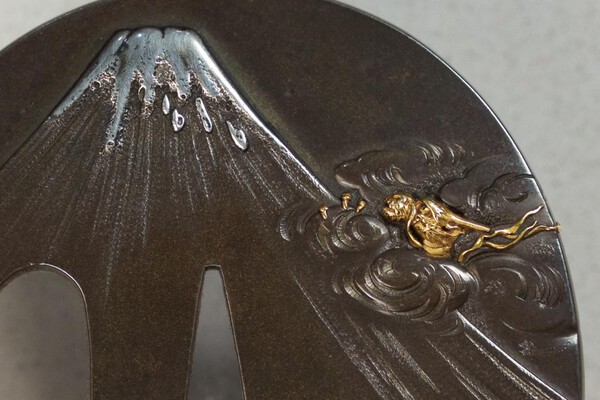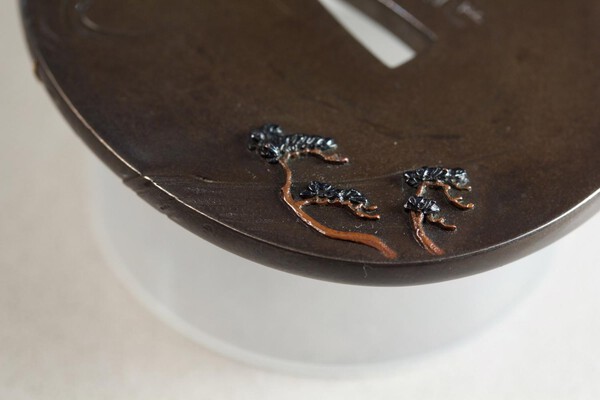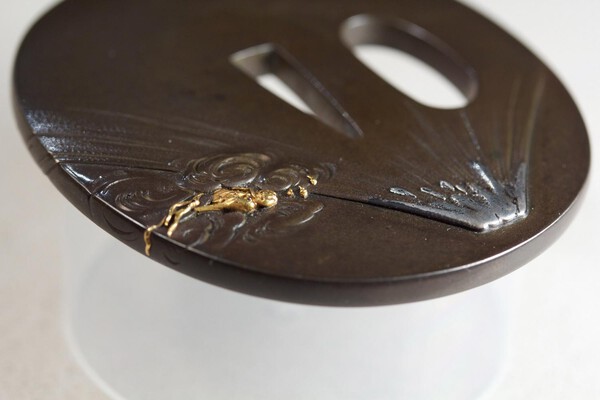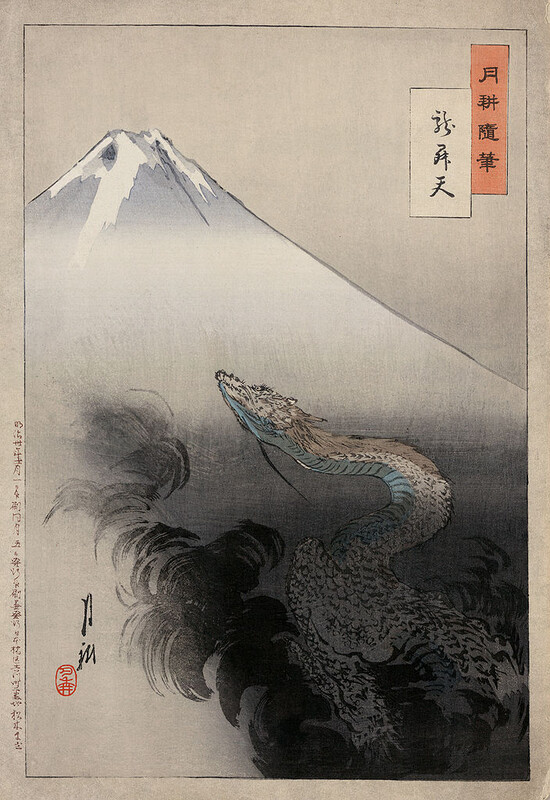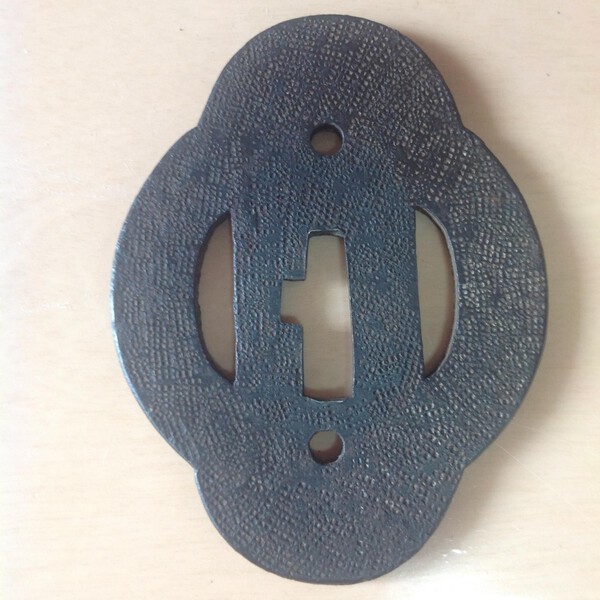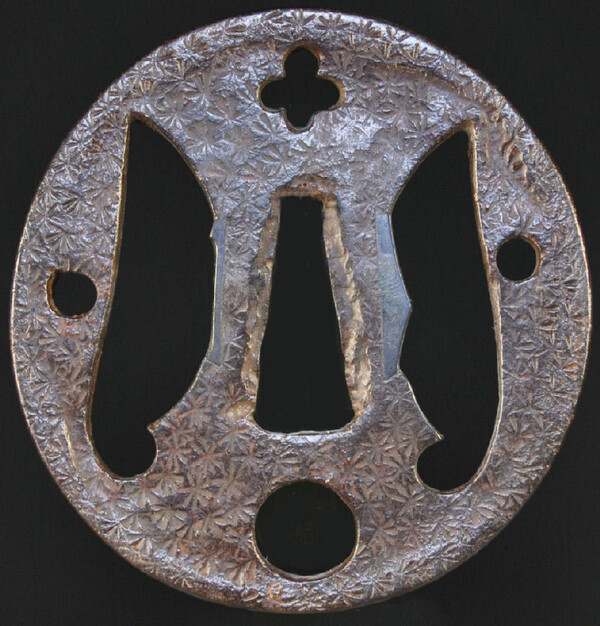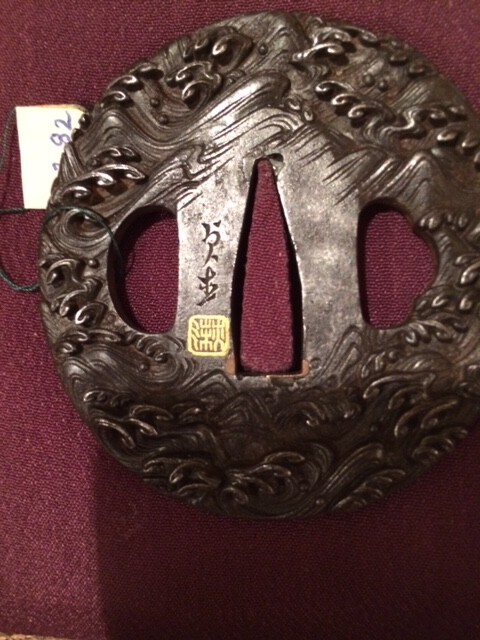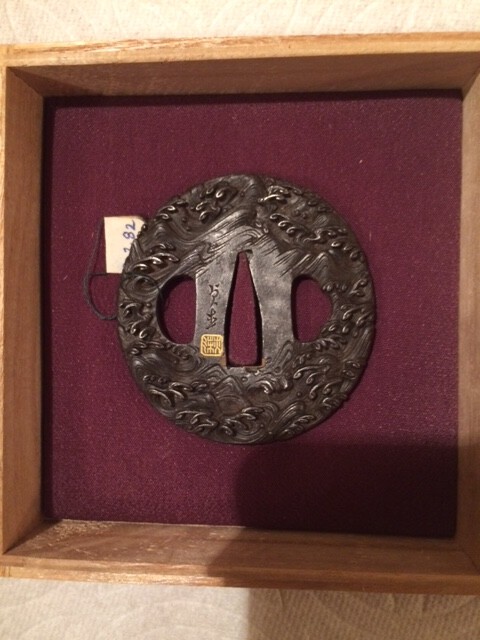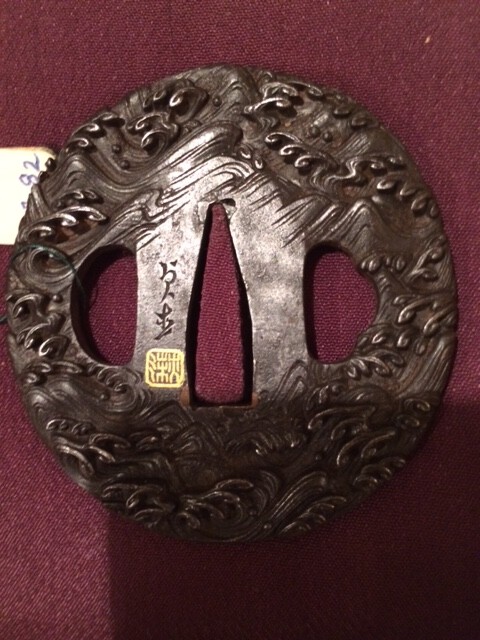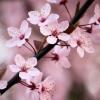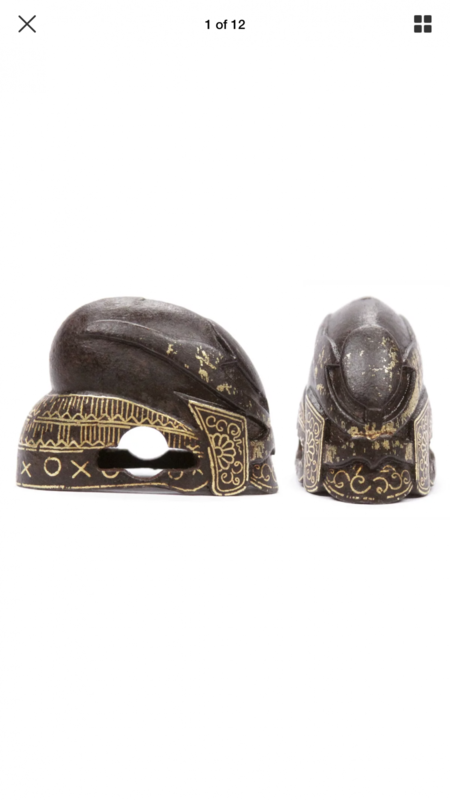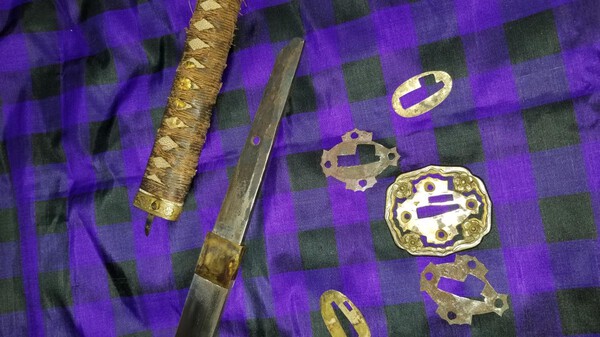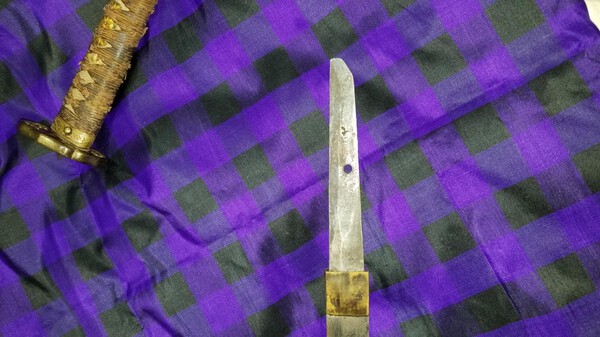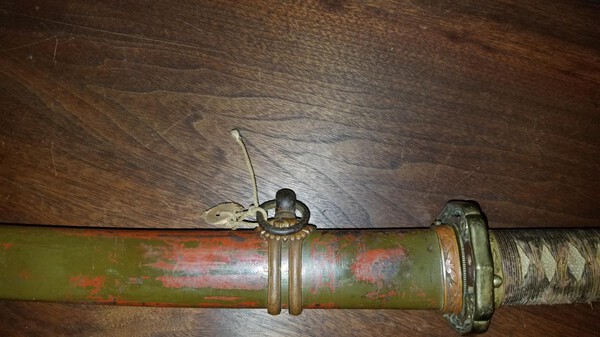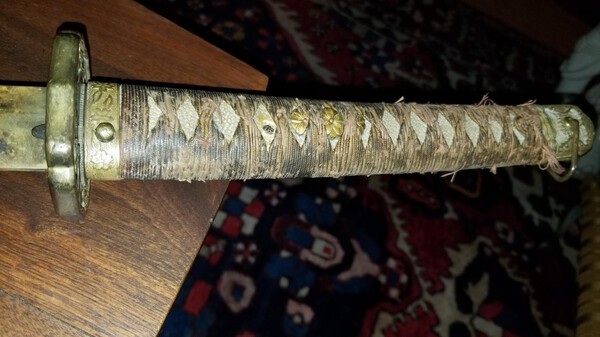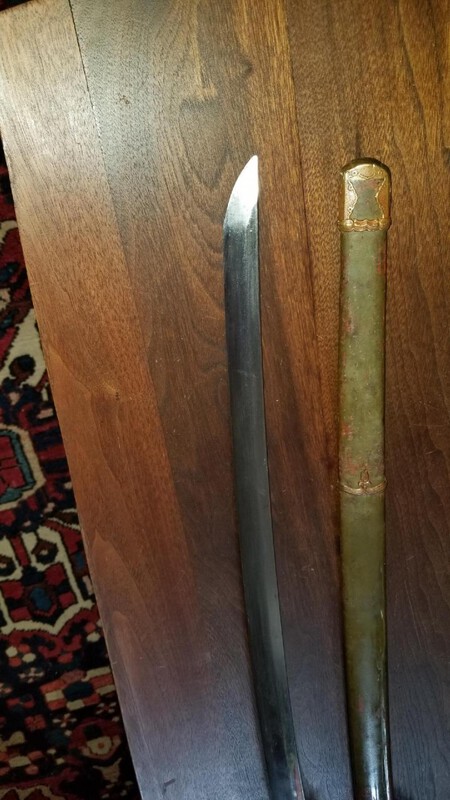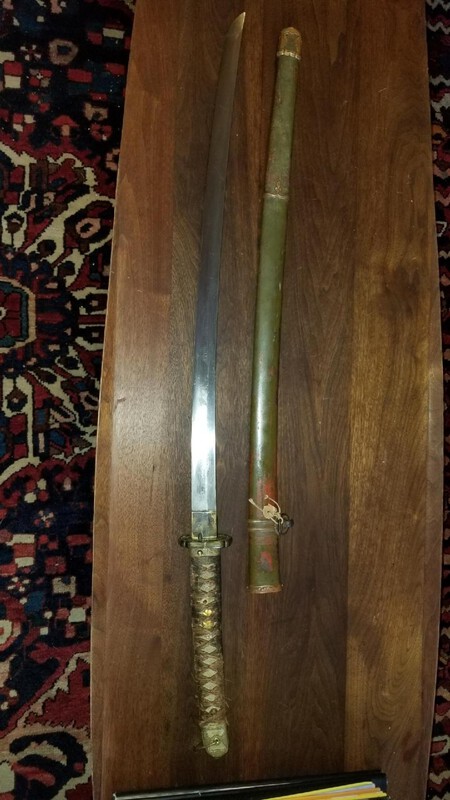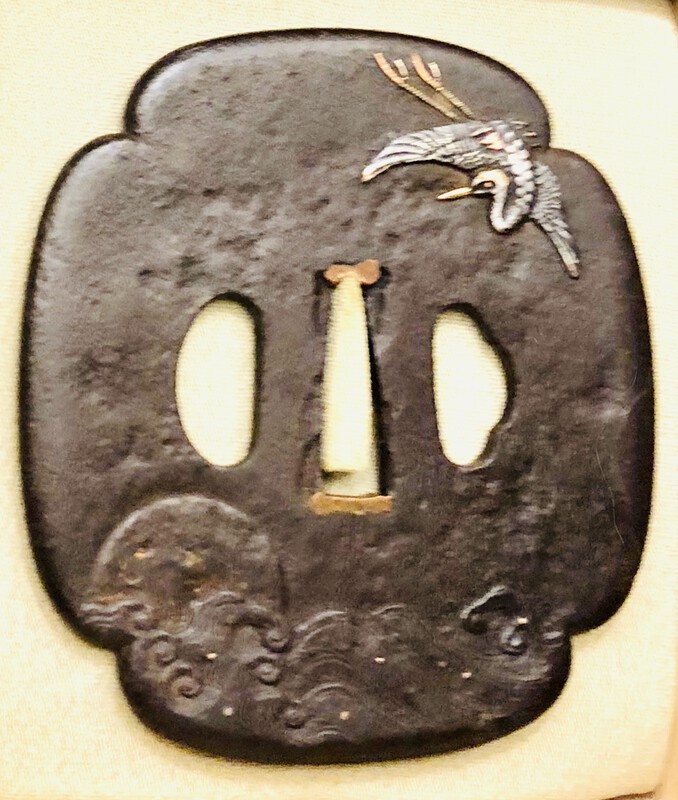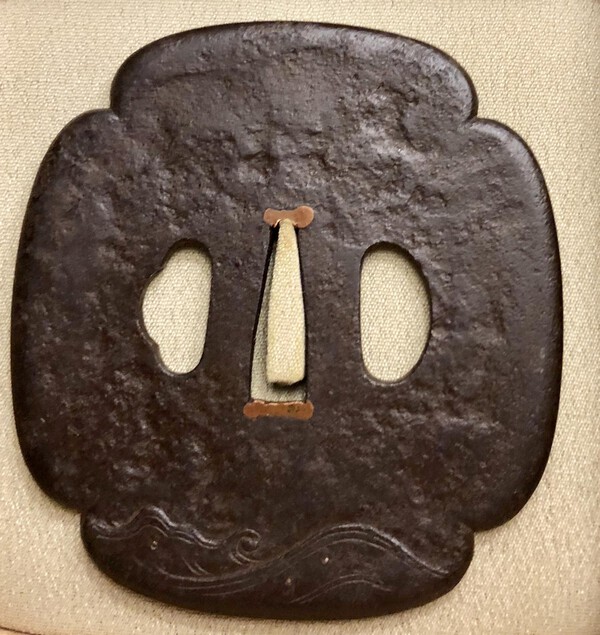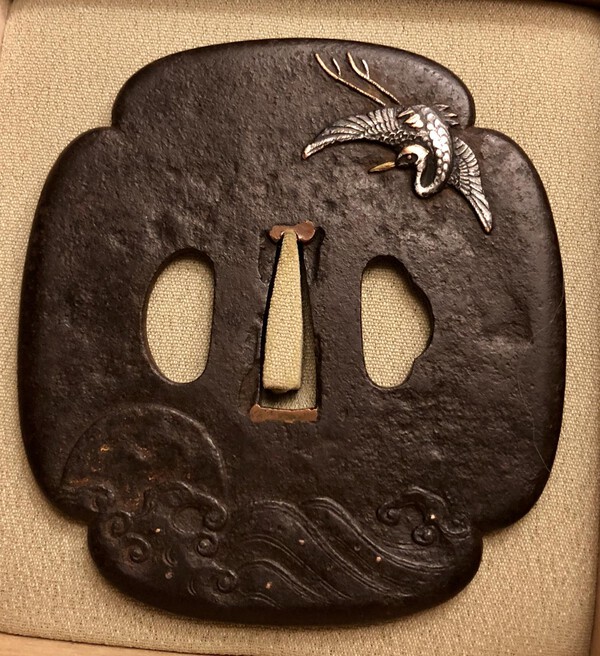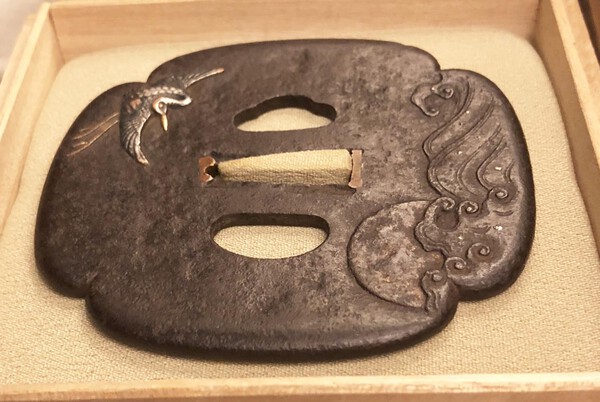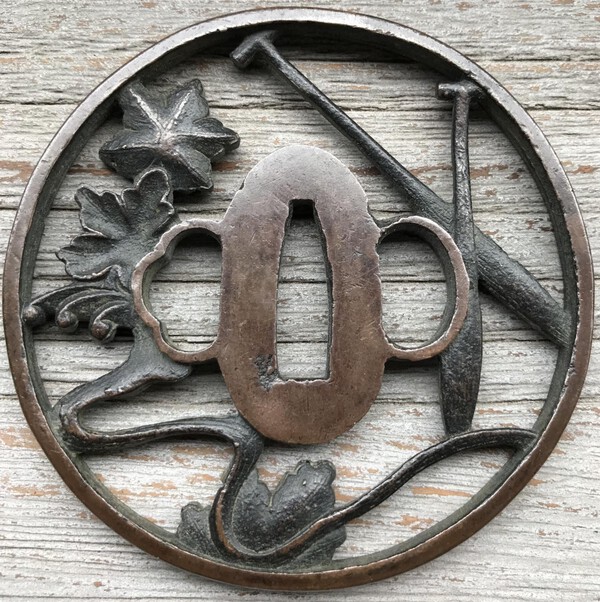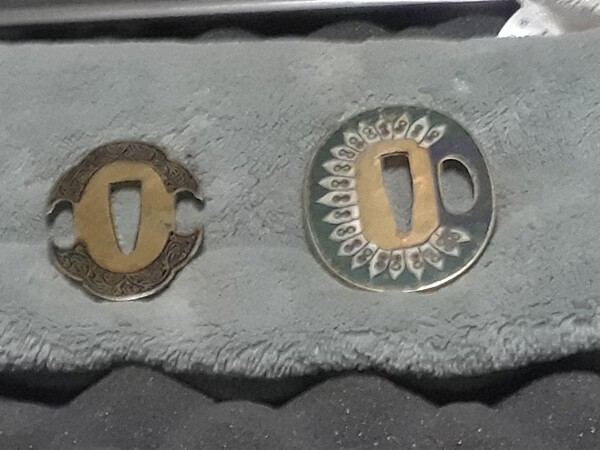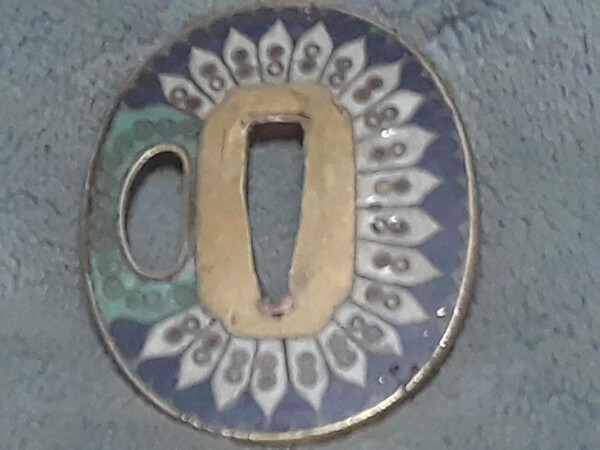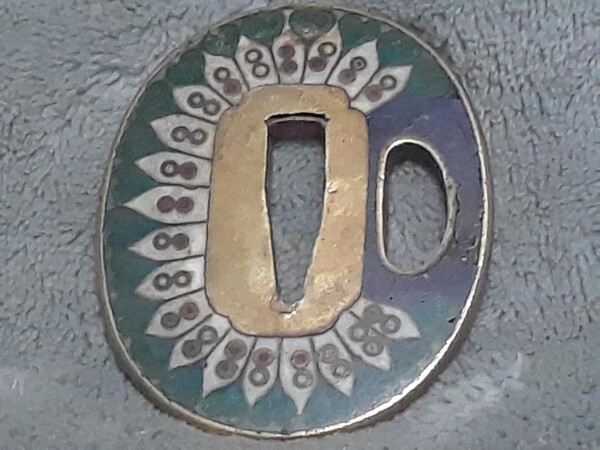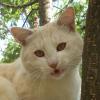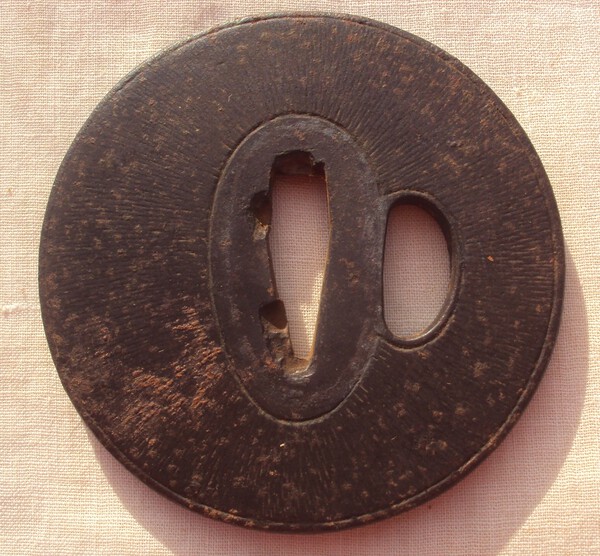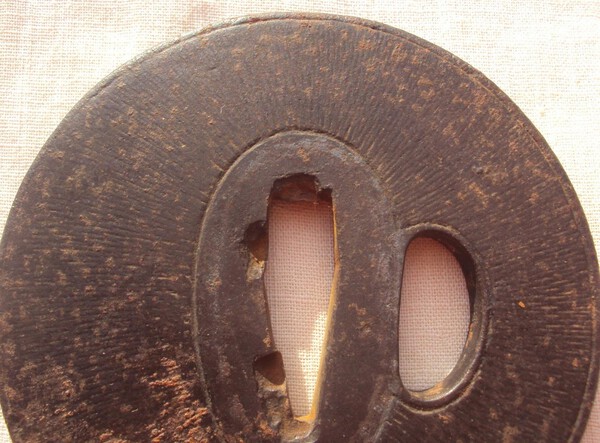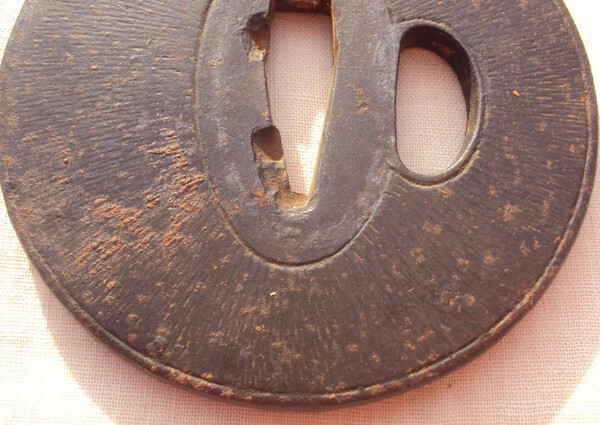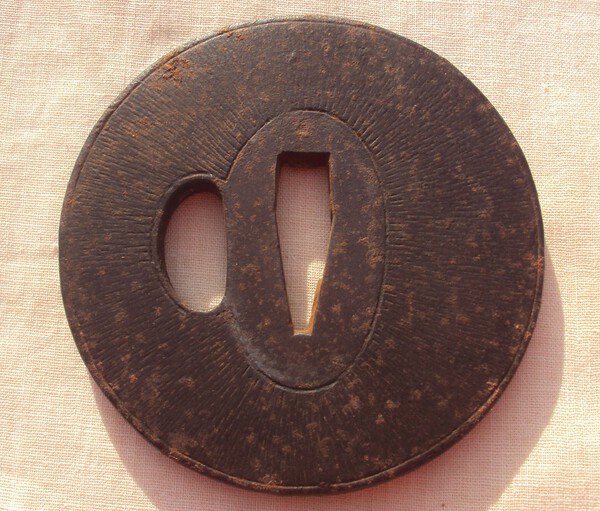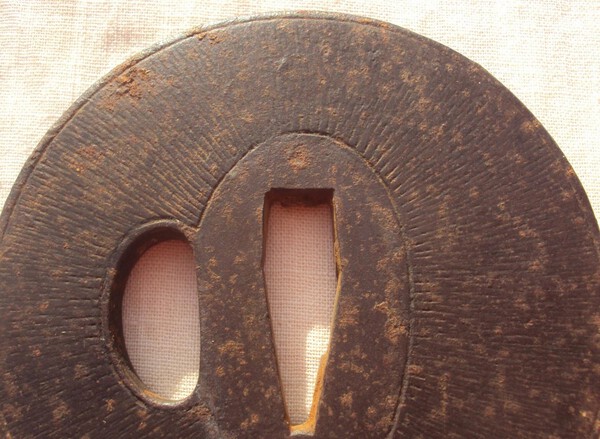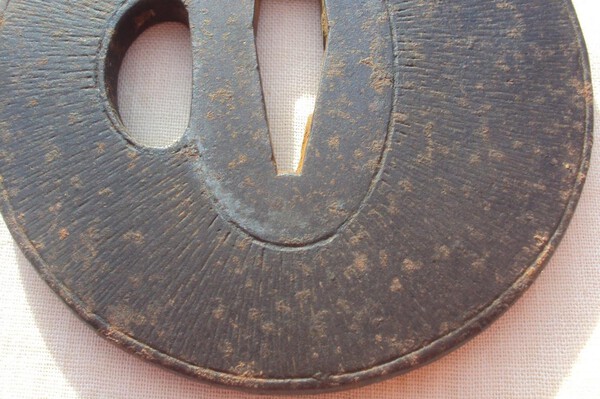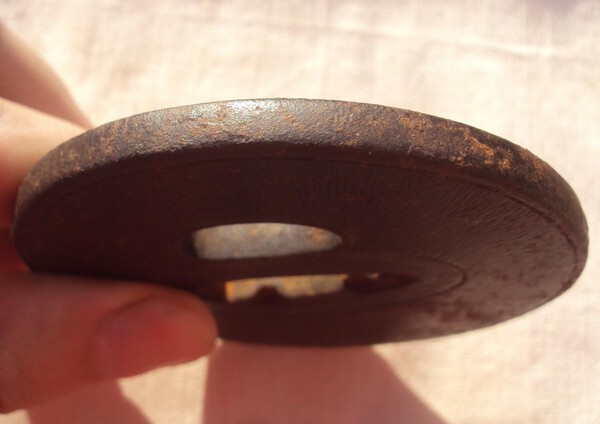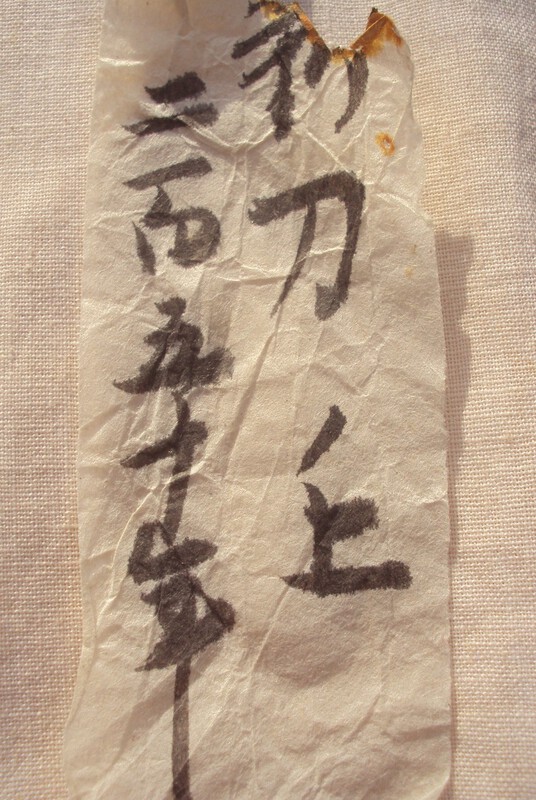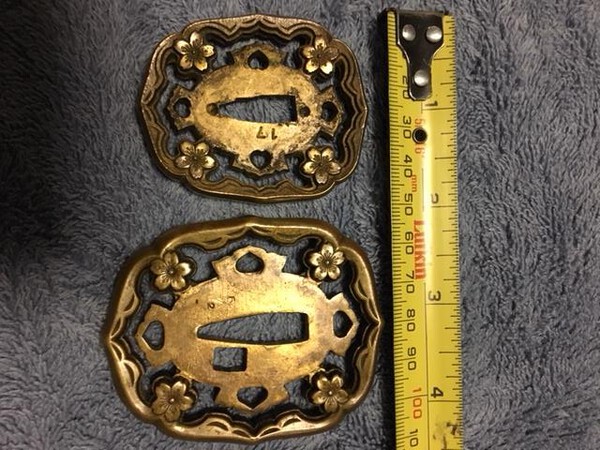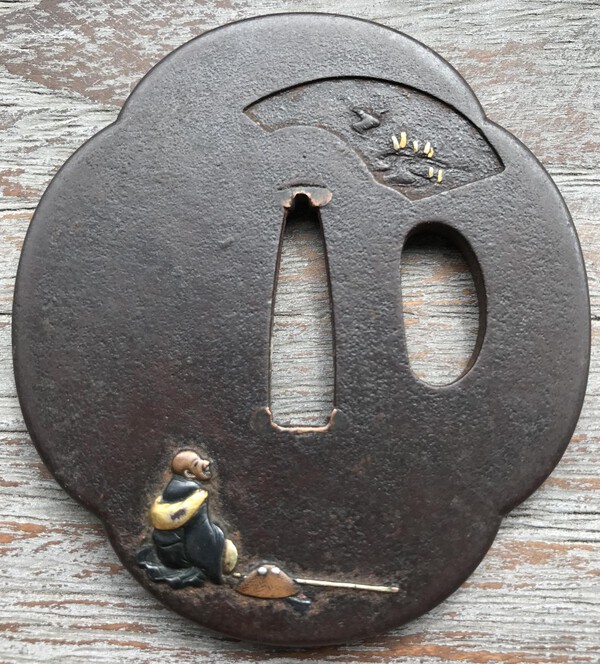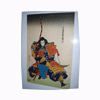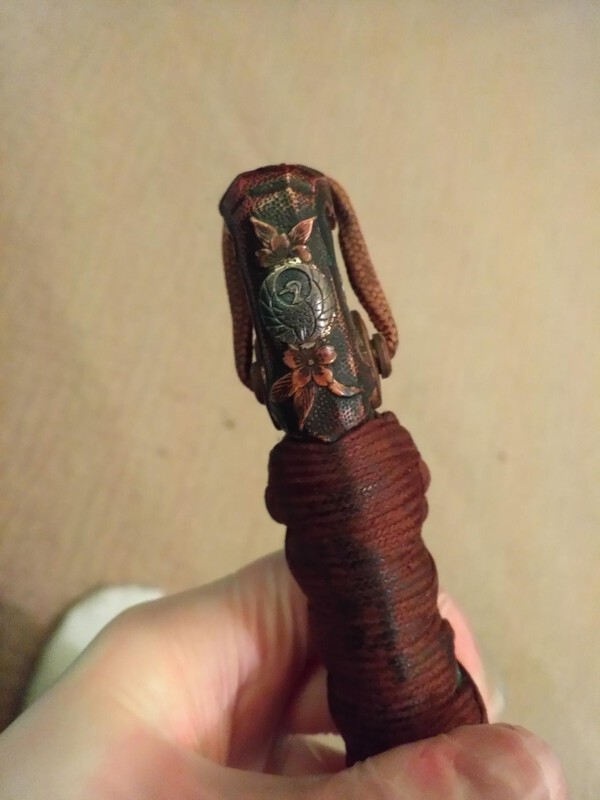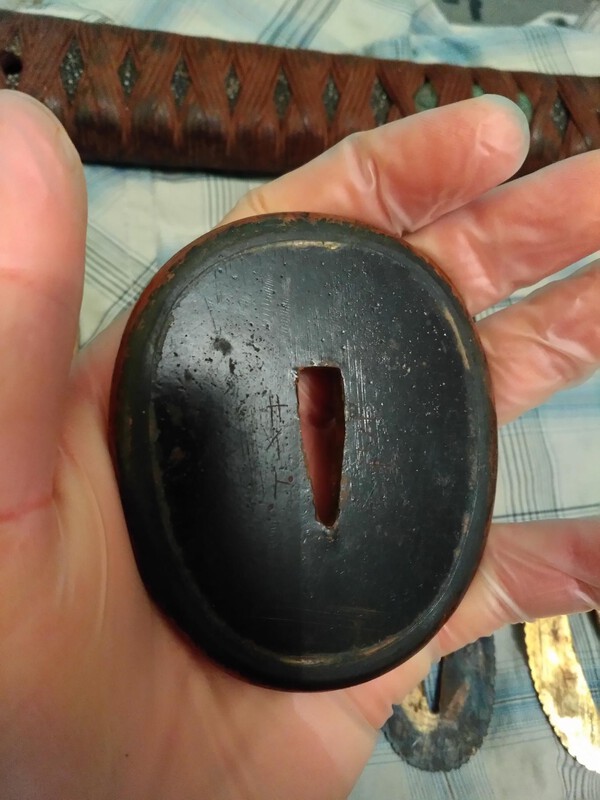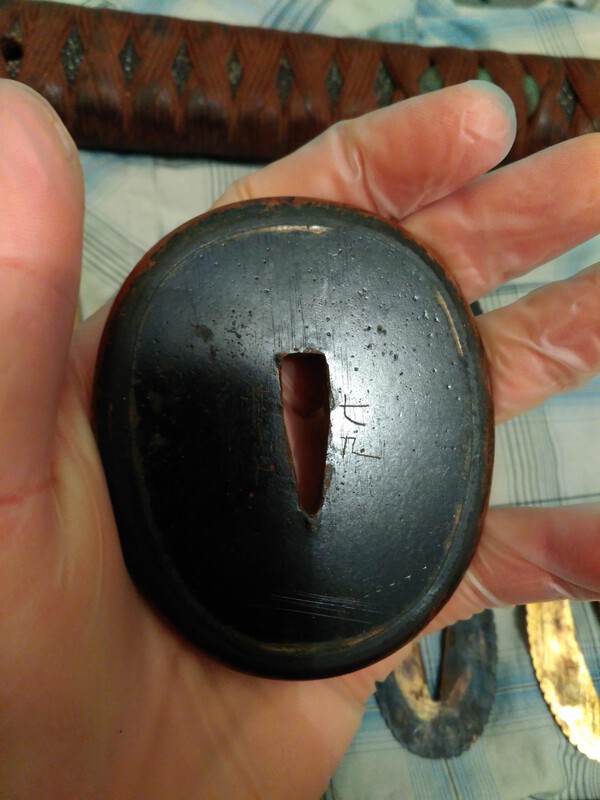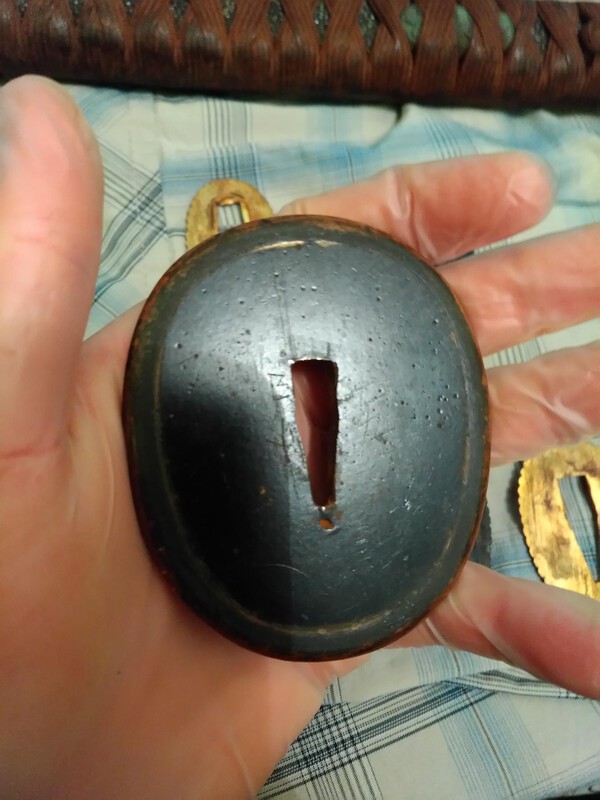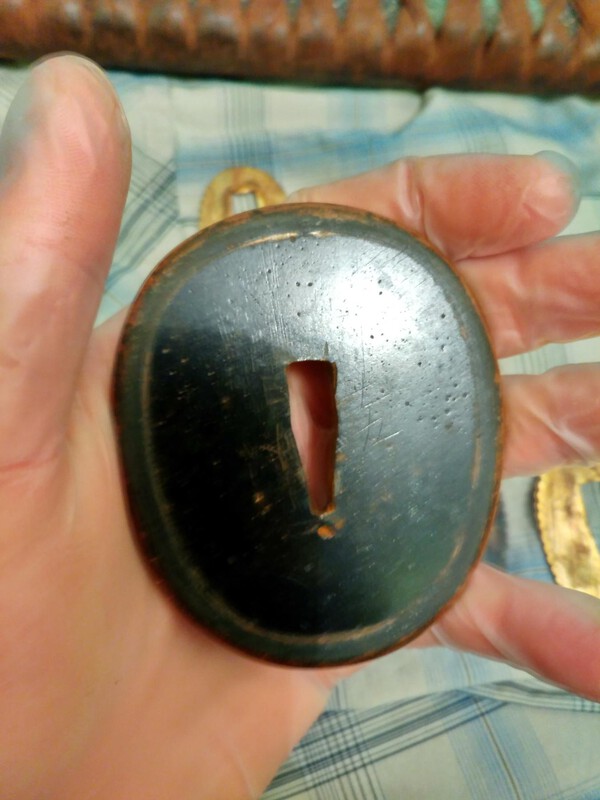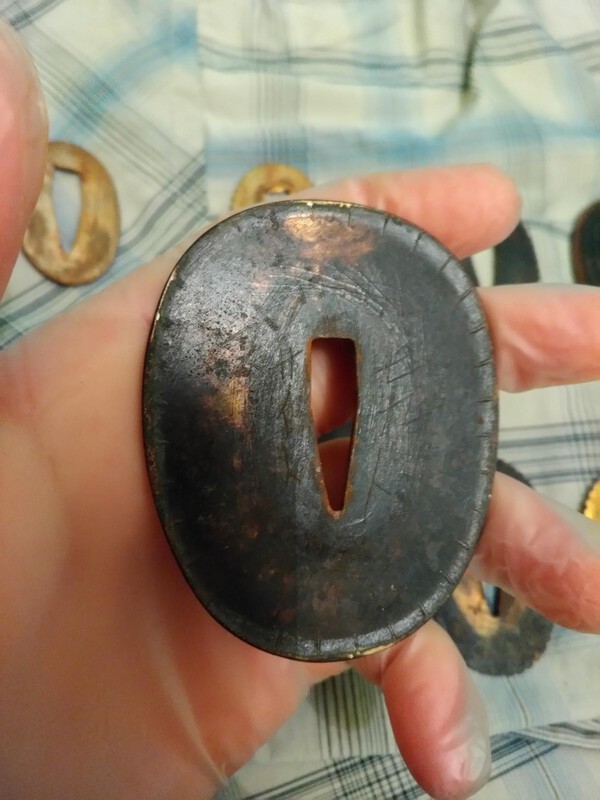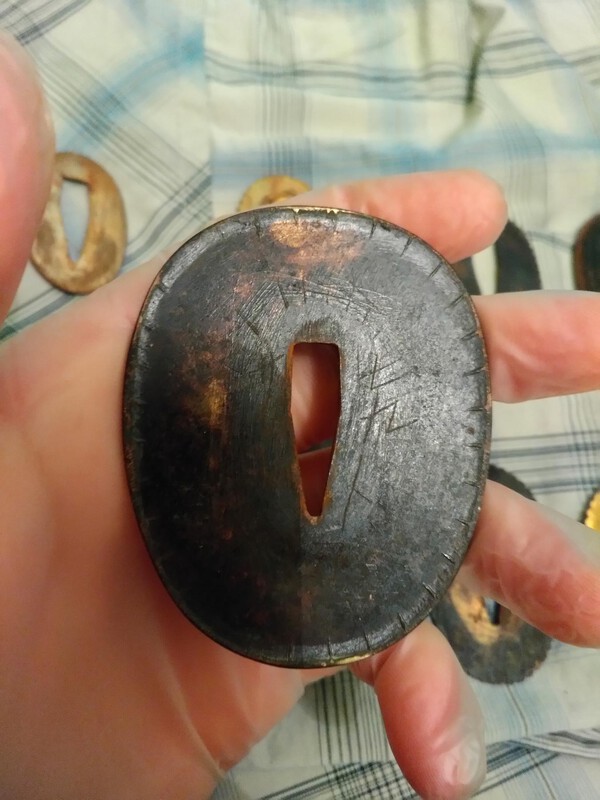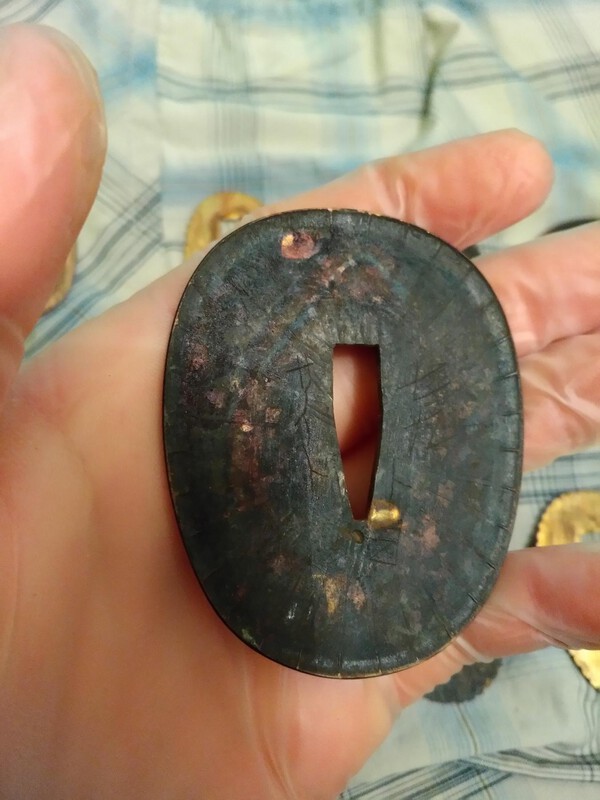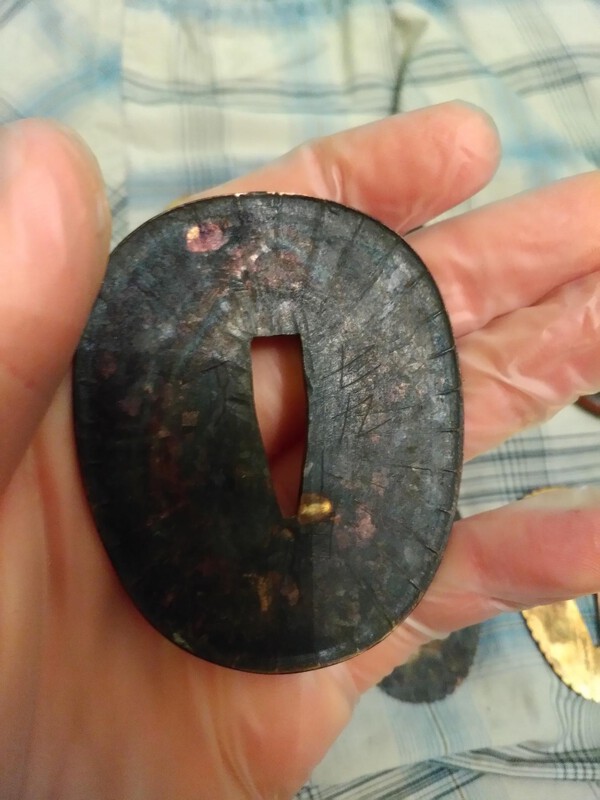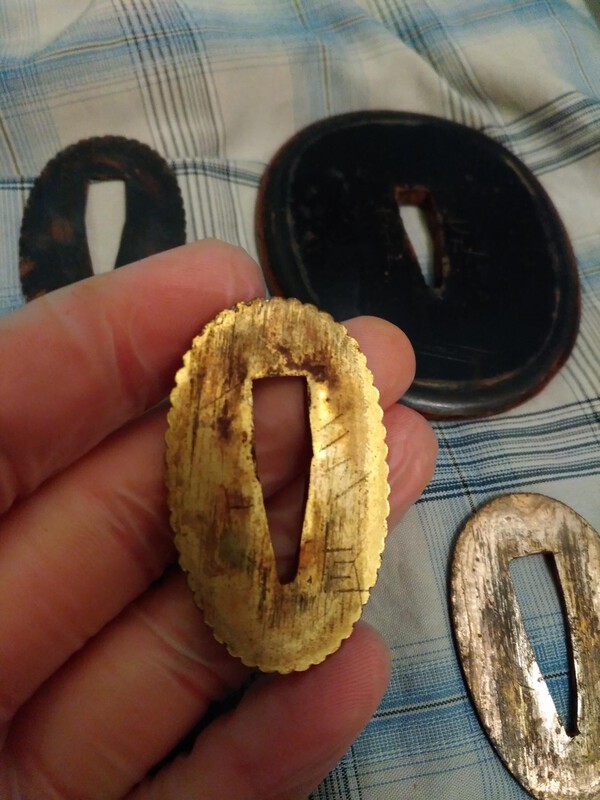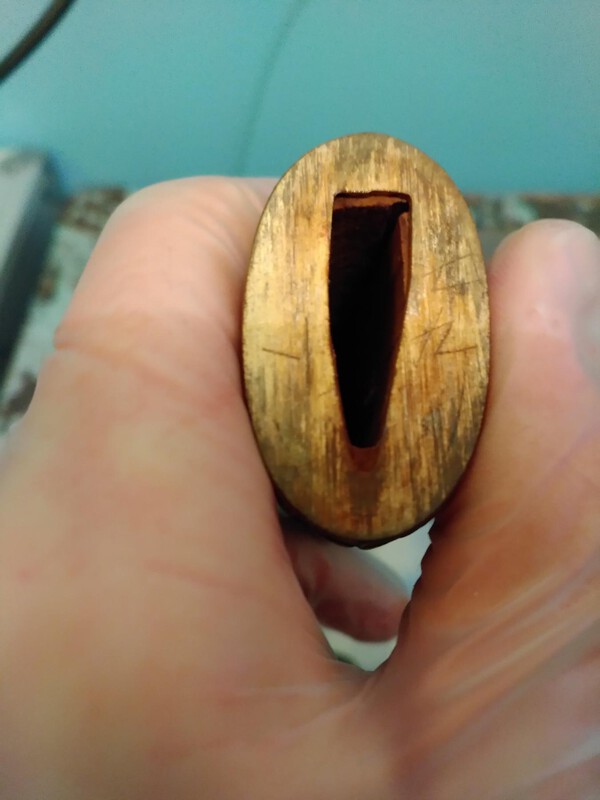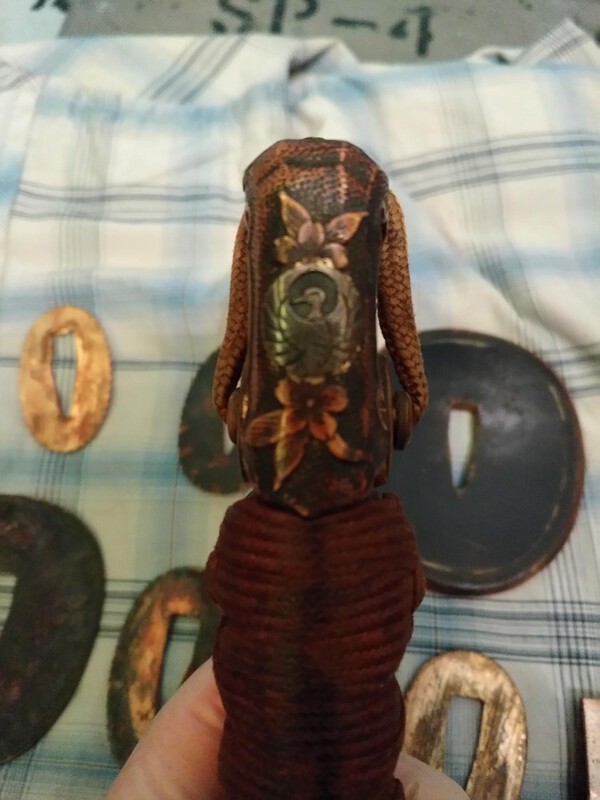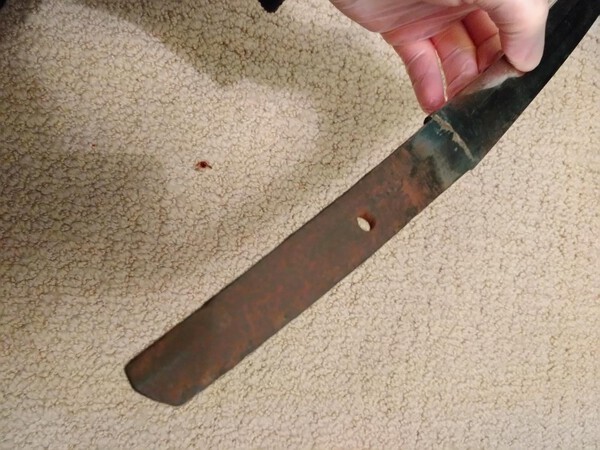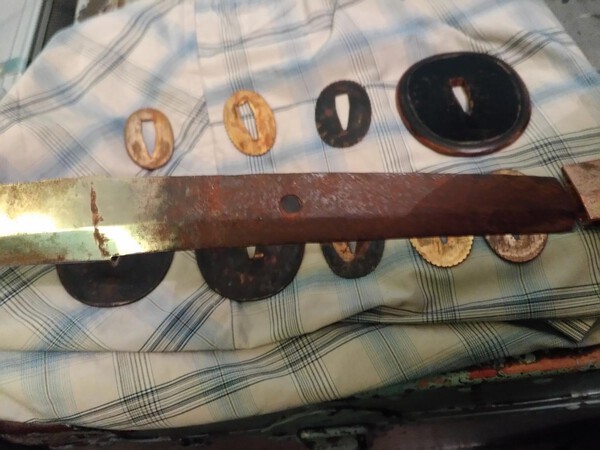Search the Community
Showing results for tags 'tsuba'.
-
Dear NMB Members: I recently acquired this nice iron Bushu ju Masafusa tsuba with some other pieces from a collector who purchased this piece in the very early 1980's. It comes with a custom fitted box. I am going to offer it to the NMB members first for a couple of days, then likely upload it to Ebay. There are no papers with it. The piece measures approximately 2-7/8ths inches high by 2-3/4 inches wide. The price is $800. Buyer pays all shipping and insurance costs. Payment by Paypal ("Friends and Family). PM me with any questions. Thanks for looking. Sorry for the sideways images. I saved them in the right configuration, but when I upload them to the NMB, they are uploading sideways. I took the photos with my cellphone. Regards, Bill E. Sheehan (Yoshimichi) Attached Thumbnails
-
I would appreciate some help in deciphering a tsuba signature that I believe is in sosho. I think the last character on the right is JU which probably implies that the two characters above are either a town or province. But apart from that.... I have looked through Sesko's signatures book - though few are in sosho - and also the variant characters shown in Self and Hirose's book on signatures. But no luck. And suggested readings would be welcome! Thanks and regards David
-
Good morning, Could you please help translating the following signature from a tsuba I just received ? This is my first try at deciphering a signature and I'm not sure where to lookup the kanjis or what the methodology is, so if a member could kindly provide some pointers, that would be much appreciated ! Thank you very much in advance Edit: Identified BUSHU (武州) JU (住) MASA (正) YOSHI (義) (KAO ?) by using http://www.jssus.org/nkp/kanji_for_tosogumei.html. Is this correct ?!?
-
Here is a quick preview of a fine copper tsuba that I am currently researching and will put up on my Tsuba Otaku website (www.tsubaotaku.com) homepage August 1st. It measures 8.0 cm wide by 8.0 cm high. It is 5.0 mm at the seppa-dai and thinner at 3.0 mm towards the rim. I will be sending photos of it to Bob Haynes tomorrow to get this feedback. The design is that of dragon and phoenix which commonly represent opposing forces a concept of dualism in ancient Chinese philosophy (yin and yang) importanted later into Japan. Everyone's polite comments and discussion are always welcome. Thank you.
-
Hi All! I recently picked up this tsuba because, to my newbie eye, it looked authentic, had a nice patina, and had an interesting shape. It has a signature which I think reads "Sandai Mei Myochin Saku" although I have a strong feeling it is gimei because I can't find any other examples with this signature. Is anyone willing to share photos of their myochin that others might use as reference?
-
A per my comment on the other post. I picked this tsuba from a Japanese dealer. It came in a nice custom box and unpapered. The dealer was thinking it dated from the Azuchi-Momoyama Period to the early Edo Period. The way I came up with to describing it as a Nanban tachi tsuba. I have only just began starting to study it in preparation for me to do some better photographs (these were taken with my iPhone) and discuss it on the homepage of my Tsuba Otaku website (www.tsubaotaku.com). The base metal is I think brass (shinchu 真鍮) a common alloy seen in other works of different schools and groups in Hizen Province during the Edo Period. There have also been the use of black and to a less extent red lacquer on the surface of the tsuba. The design is of twin dragons and a apple. It measures 7.7 cm long by 6.9 cm wide. As always feel free to discuss politely. Thank you.
-
Dear members, And here is number 3: Dimensions: 7,48 x 7,86 x 0,46 cm Weight: 121 gr Metal: iron Also needs some cleaning due to glue from stickers Looking out for your replies. Thanks!
-
Hello all, I'd like to learn more about a tsuba that has been in my family for years, well before WW2. The text is hard to read much less photograph, but I've done my best. Does anyone recognize it? I'm most interested in how old it is and who made it. Thanks in advance for any info you can supply!
-
Recently got this small kinko tsuba as a souvenir of my trip to Japan. Mei: Nakagawa Hidekuni 仲川秀國 Era: mid 1800s Dimensions: 2.25" x 2.5" Materials: shibuichi ground with gold, silver, shakudo, and copper details Subject: Mt. Fuji with clouds, dragon, and trees The signature of "Nakagawa Hidekuni" (using the "Nakagawa" from his birth father, but "Hidekuni" from his teacher Hideoki) is unusual, judging from examples I have found online. That coupled with the workmanship makes me suspect that this piece may have been a relatively early one from Hidekuni's career, but that is just a suspicion. Artist Info Other Signatures Kawarabayashi Hidekuni 川原林秀國 Kawa Hidekuni 川秀國 Tenkōdō Hidekuni 天光堂秀國 Kinryūsai Hidekuni 金龍斎秀國 Biography 文政八年三月十日 (1825-04-27 Wed.) born Daizō 代蔵 in Yonago 米子, Hōki Assisted his father, a kinkō artist of whom only the name Nakagawa 仲川 is known Ca. 1843 at age 18 he moved to Kyōto to study under Kawarabayashi Hideoki 川原林秀興 (note, Hideoki was a student of the famous Ōtsuki Mitsuoki 光興, one of the Kyōto Sansaku) Married Hideoki’s second daughter and was adopted into the Kawarabayashi family In 1851 when Hidekuni was ca. age 26, Hideoki passed away (Date unknown) son Hideyoshi 秀睦 born, became the 3rd and last artist of this line 明治二十四年九月二十七日 (1891-09-27 Sunday) Hidekuni passed away at age 67 Notes After his gō (e.g. Kinryūsai or Tenkōdō) he often signed Kawa Hidekuni 川秀國, which intersects with both his birth and adopted family names Nakagawa 仲川 and Kawarabayashi 川原林. He seems to have collaborated several times with other Hideoki students including Gassan Matsuo. In addition to fittings he made incense burners, inro, and other items. Quotes "Kawarabayashi Hideoki…closely resembled Mitsuoki, but never attained to his skill, though he taught his adopted son, Hidekuni (who worked in Kyōto and Ōsaka…), to be a greater artist than himself." Japanese Sword Guards, Okabe Kakuya "…his carving technique had a more delicate feeling than that of his teacher, Hideoki". Nihonto.com, Fred Weissberg "Other great students in [the Ōtsuki Mitsuoki] school were Tokuoki, Hideoki, Minayama Oki, Tenkodo Hidekuni, Matsuo Gassan, and his son Mitsuhiro." Yuhindo.com, Darcy Brockbank Resources Index of Japanese Sword Literature Genealogies of Japanese Tsuba and Toso-kinko Artists (Sesko) The Japanese toso-kinko Schools (Sesko) Bonhams items Boston MFA items Nihonto.com ... (PS — It is a popular motif of course; I was partly drawn to it because during my trip I glimpsed Mt. Fuji partly obscured by clouds, but also I was reminded of this famous print by Ogata Gekko, Ryu Shoten.)
-
In July 2014 there was a thread on udenuki-no-ana - two holes near the edge of the tsuba. A year earlier, there was another thread on the shape of the nakago-ana. I have just acquired the attached tsuba, recently bought in Tokyo, which has a hole at the top and bottom, thus presumably not udenuki-ana. The hitsu-ana are unusually narrow and there is a notch in one side of the seppa. The nakago-ana is of oblong shape rather than pointed. Can anyone shed any light on this tsuba please? In the same post, kissakai posted the other attached image. I have also acquired two tsuba, again bought recently in Tokyo, with the same motif. Is it known what the design is (flowers, pine, snowflakes, or?) please? Thanks and regards David
-
Hello, I know very little about Japanese swords and probably even less about Japanese sword guards - from what I was able to gather, this could be a Shoami tsuba. Could you tell me more about it - when it was made (I was thinking of late Edo) and who might have signed it (several kanji on the surface, one of which seems to be identifiable)? Thank you in advance for your replies! Didier
-
I bought what looked to be a nicely-preserved Heianjo tsuba from bushido*omotenashi*bakuhu on eBay (https://www.ebay.com/usr/bushido*omotenashi*bakuhu), only to find that it was a cleverly-PRINTED overlay, instead of brass inlay. It was very well done, & impossible to tell just from photos. Per my conversation with Brian, I was going to let him slide by, until he decided not to refund my return shipment fee (he had also refused to send a prepaid shipping label). eBay forced him to refund my tsuba payment, but they haven't yet stepped in on the shipping cost. So I highly recommend that you do due-diligence in dealing with this seller, as his items may not be shoshin.
-
Dear NMB Members: I need some help translating the mei on this tsuba. I think the first character is "Sada." Not sure of the second character or the school (Mito or Omori?). Any help is appreciated. Regards, Bill E. Sheehan
-
Good morning and hello gents. How is everyone today so I’m wanting to start a thread for fittings inspired by samurai armor and or accessory’s they would of had. As I found my self a unique kashira in the shape and the style of kabuto and I’m curious what else is out there in the high end of things. As I’m brain storming a pontential Mount up on what I can find. The kashira is iron with excuse the spelling Noume zonga gold inlay yes I know I spelt it wrong not sure the correct way. I’m guessing Early to mid Edo. Photo is taken from the sellers listing as I am not home to take better Not for resale.
-
Hello, someone messaged me saying they have this sword for sale. the problem i have is identifying the age and if the blade is original or not. the tsuba is large and the tang doesn't look right to me. also, the pictures are not the best. any help would be great thanks.
-
Does anyone remember seeing this actual Tsuba? I seem to remember seeing it on a catalog or at an exhibition. Trying to narrow down the provenance. Thanks, Phil
-
Dear members, Here is number 2: Dimensions: 7,14 x 7,66 x 0,48 cm Weight: 94 gr Metal: iron Needs some cleaning at the seppa dai (glue from sticker) Looking out for your replies. Thanks!
-
Dear members, Just back from a little holiday in France. I came back with 3 tsuba! This is the first one: dimensions: 7,72 x 7,60 x 0,54 cm weight: 88 gr metal: copper (...?) Looking out for your comments Thanks! Yves D.
-
Hey all, I have a couple of tsuba I thought I would show and get opinions on. I saw these and have not too much knowledge of them, though I know they're probably Edo-period (?) as I read that ornamental fittings came more into vogue around that time. I could and (probably be) totally off base with these. Either way, I didn't pay too much for them. Let me know what you think and any information you might be able to glean from the pictures. The first tsuba is 5.45cm x 4.1cm, Thickness: 0.5cm, Inside hole is 2.4cm x 0.75cm(max width) x 0.2cm(min width) The second tsuba is 6cm x 4.7cm, thickness: 0.5cm, Inside hole is 2.4cm x 0.7cm (max width) x 0.2cm (min width) Thanks for any education guys!
-
Hello Maybe someone can help me with school and date of manufacturing of this iron tsuba? Diameter is 76 mm, thickess 5.5 mm Some paper label was attached...
-
Do any collectors know the origin and use of this "mini" tsuba, photographed against the regular size example. They are obviously both pierced, but the mini one has no provision for a securing spring clip or leather strap.
-
-
Hi Members and visitors, Topic; Papers for tsuba. Am interested in having some idea of what is involved, time and cost. Additionally, what papers are best and would run with tsuba much like a gemstone certificate by GIA. Any advice or opinion will be appreciated. Thank You in advance, Ed F
-
Few bits out of collection on ebay. But I can talk direct https://ebay.com/usr/tosogu_antiques P.S. Maybe it should be moved to ebay section...
-
So I recently acquired a wakizashi from a relative and wanted to learn a bit more about it. The sword was brought back from ww2 along with a few bayonets and an officer's sword. The blade itself is completely devoid of any kanji but the tsuba and seppa's have some kanji on them. Also on the kashira (hope that is the right term) there is a crest which from what I can tell is from the mori clan though I'm not entirely sure as there seems to be quite a few different variations of that particular crest. There are a few peculiarities with the sword however, the first is that there is only one peg holding the blade in place instead of the usual two. The second is that the scabbard is a good five inches longer than the actual blade. Also of note is that the entire guard is comprised of 6 seppa (seppa or seppas?) two slightly larger pieces and a central thicker tsuba made of copper. All of the seppa are either a brass or similar composite but two are very dark from ageing and from contact with the other non brass pieces. Any and all input is greatly appreciated.


